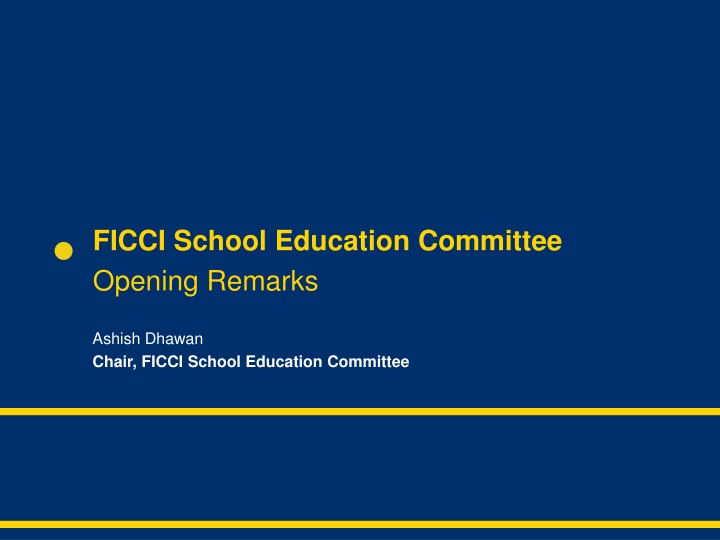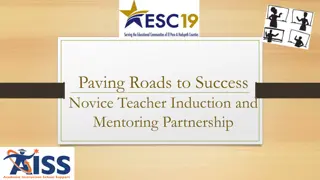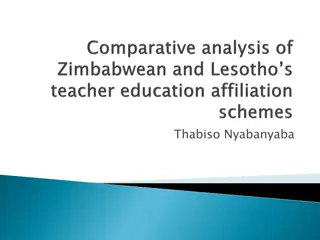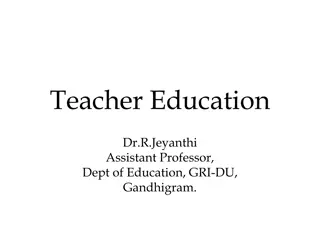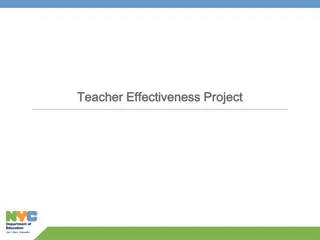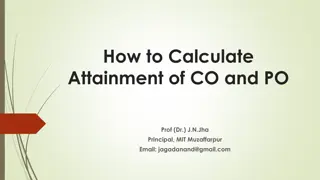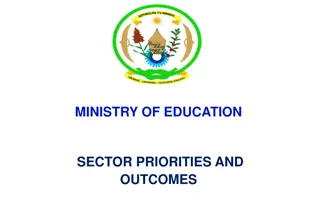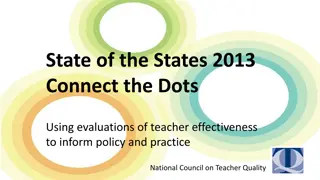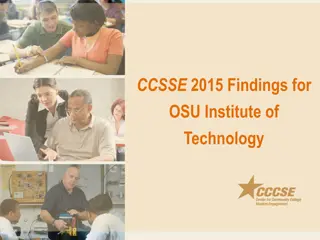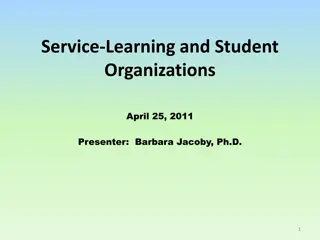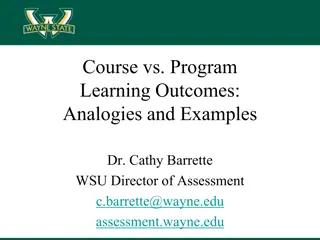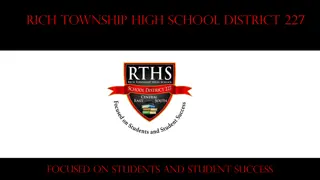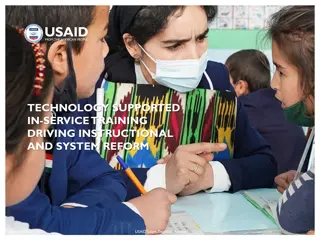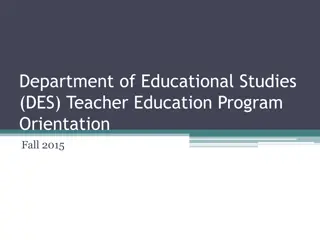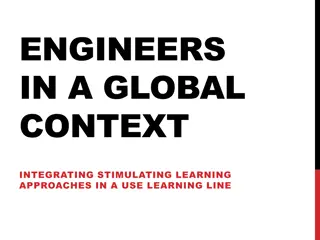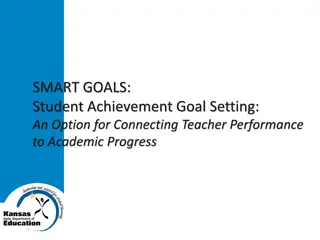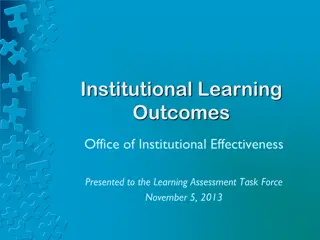Innovating Teacher Education with Technology and Assessing Student Outcomes
The FICCI School Education Committee has identified key focus areas such as technology integration in teacher education and assessing student outcomes. They have developed training videos for teachers and are advocating for the use of technology-based resources in education. Additionally, there is a focus on assessing cognitive and non-cognitive skills of students through research and global best practices. The goal is to enhance teacher training methods and improve student assessment practices.
Download Presentation

Please find below an Image/Link to download the presentation.
The content on the website is provided AS IS for your information and personal use only. It may not be sold, licensed, or shared on other websites without obtaining consent from the author.If you encounter any issues during the download, it is possible that the publisher has removed the file from their server.
You are allowed to download the files provided on this website for personal or commercial use, subject to the condition that they are used lawfully. All files are the property of their respective owners.
The content on the website is provided AS IS for your information and personal use only. It may not be sold, licensed, or shared on other websites without obtaining consent from the author.
E N D
Presentation Transcript
FICCI School Education Committee Opening Remarks Ashish Dhawan Chair, FICCI School Education Committee
2013 - 2014 Sub-Committees Working Groups were formed to focus on the following areas: Technology in Teacher Education Private Sector Participation in Education Public-Private Partnership in Education Cognitive and Non-cognitive Student Assessment Results Framework Document Right to Education 2
Technology in Teacher Education There is incredible potential to bring innovation, creativity and scale to Teacher Education through the use of technology. Specifically to: Personalize and pace training per the capacity and requirements of the individual teacher Address large-scale and create communities and support groups for ongoing peer interaction Overview To build capacity-building content for teachers that is low cost, high quality, community led, expert facilitated Scope Have developed and field-tested 30 training videos for teachers, specifically focused on the NCERT Class 1-5 Math Magic curriculum Field Group Discussions reveal that teachers find these resources useful and effective especially as they focus on common student misconceptions Key Findings In the ecosystem, there are a lot of practitioners creating technology based resources for teachers, and it is essential to bring everyone together to discuss common insights and challenges Government institutions such as SCERTs and DIETs can fit-in these technology based resources in their existing pre-service and in-service programs 3
Cognitive and Non-Cognitive Student Assessment As the focus of the central government shifts from access to the quality of education, states have been mandated to implemented their own student assessments to monitor student outcomes, and plan resources accordingly Overview There is also a need to discuss the achievement of non-cognitive competencies, and understand how these can be assessed To conduct extensive primary and secondary research, and compile global and national best practices in large-scale learner assessments and developing and assessing critical non-cognitive skills Scope To author two key documents Guidelines for Large-Scale Learner Assessments: Practices for Design, Implementation and Use of Assessments by States and A Framework for Developing and Assessing Key Non-Cognitive Skills The guidelines emphasize international best practice in the design, implementation and use of assessment of results, which can assist state decision-makers as they embark on this journey Key Findings Primary research conducted in Karnataka, Madhya Pradesh and Gujarat, and secondary case-studies of Brazil, Chile and Australia showcase a number of best-practices that other states can incorporate International initiatives in the non-cognitive domain are highlighted to build the context and need for a framework in India. A Personal and Social Well-Being (PSWB) framework is also suggested, including measures to assess and track 4
Private Sector Participation in Education K-12 sector in India has 1.46 million schools with an enrolment of 253 million students - schools have grown at a CAGR of 2.5% and enrolment has grown at a CAGR of 2.2% since 2005-06 Indian K-12 system is segmented by ownership, level of education and board of affiliation The Indian K-12 system is facing two major challenges- access and quality (high drop-out rates, OoSC, high PTR, lack of trained teachers and low learning levels) Overview Private sector has contributed significantly to the K-12 system. Although it accounts for 25% share in schools , the enrolment share is at 40%. The number of private schools has increased at a CAGR of 4% in the last five years Board exam results and independent studies such as ASER and national standardized assessments show better performance of students from states such as Maharashtra, Rajasthan, Andhra Pradesh and Gujarat Scope There are currently ~ 339,000 private schools and it is expected to grow significantly. We would need an additional ~130,000 schools by 2022 considering overall GER target of 95% In 2022, private sector is expected to account for 55%-60% share in enrolment, however, private schools face challenges that are regulatory and financial in nature Government needs to recognize this and standardize norms across states and boards, move from an input based regulatory system to an output/outcome based system Allow schools to operate on short-term lease/ rental model, provide for pooling of government and private school resources for effective utilization, reduce land area requirements, provide flexibility in land ownership, flexibility in teacher salaries and have a unified single window clearance by doing away with multiple licensing system The government and the private sector need to collaborate and work together in contributing to the growth and quality of school education Key Findings 5
Public Private Partnership in Education Overview There is need identified to create a robust PPP ecosystem for operators, government and philanthropies to interact and share learning and innovation pathways. This ecosystem is vital to ensure that PPPs are financially viable, operationally effective and fulfil their promise of introducing critical quality into the Indian education system This report traces the evolution of PPPs in education in India, defines the need and opportunity for whole- school model of PPP implementation and draws learning from domestic and international experience of PPPs to outline elements and characteristics of effective PPPs Given the current interest in PPPs in India, this report examines the whole school management and adoption models of PPP, which are the two models with the most potential to create impact Scope India can draw valuable insights from countries (such as the USA, England, Columbia, Uganda, and Pakistan) that have used PPPs as a policy response to quality and access issues in school education. Drawing on global best practices from them, the report suggests structural principles that need to be addressed in the design of a PPP. These include: Private operators should have autonomy to introduce innovation Government should reimburse private operators the full amount of per child costs in a timely manner to ensure financial viability Full transparency in selection process of operators High accountability standards with well-defined evaluation and assessment methods Clarity of intervention policies and termination procedure for non-performing operators Key Findings 6
Results Framework Document Results Framework Document (RFD) is an important tool that can be leveraged to enhance the effectiveness of public spending on school education Overview Developed recommendations for implementing a State RFD (or equivalent) performance management tool Description of the RFD, sections, evaluation methodology and challenges Scope Recommendations on enhancing the effectiveness of an RFD Suggested sub-goals and success indicators for an illustrative State RFD Feedback and suggestions from education functionaries Break down the overall objectives of the ministry into sub-goals to identify specific action items Identify a holistic range of success indicators (input, intermediate output, outcome, financial and policy) Key Findings Key pre-requisite for developing a state RFD is a five-year strategic plan and working backwards to set goals for each year Create and build ownership around the use an RFD/performance-management tool Disseminate and assign responsibility for achievement of goals and targets 7
